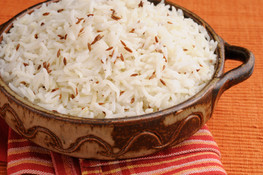Rice Notes
- Chef Savant

- Sep 4, 2020
- 3 min read
Updated: Mar 15, 2021
With so many types of rice and grains to enjoy, is there a way to ensure the grains don’t overcook while still being infused with flavor?

Well here are a few simple tips on how to keep your rice flavorful, while enjoying tender grains. First off, it’s important to know simmering grains instead of boiling them allows them to absorb the liquid slower so that it gets cooked all the way through. While boiling the rice can cause the exterior to cook too fast and leaving the interior portion undercooked and in some cases a little firm/crunchy.
Also, knowing the ratio of water to rice can be helpful as it will not always be the same depending on the type of rice/grain you choose. As a rule of thumb, white rice, is usually a 2 to 1 ratio, while a brown rice, red rice, and blended rices are usually more of a 3 to 1. Again, this is a rule of thumb and should not be treated as an exact science. Technicalities like the age of the rice and elevation’s affect on the boiling point of water can come into play lending subtle effects on the cooking process. For simplicity sake, if you’re NOT using a rice cooker, and you find your rice short on water, you can always add a little more to your rice as it simmers. Just remember if you do, do NOT add COLD water, as it could create textural issues in the finish of your rice. Alternatively, if you’re cooking your rice and find that it gets finished before all of the liquid is absorbed, you can simply remove it from the heat, drain the excess liquid, cap the rice for about a minute, fluff it with a fork, and enjoy!
Salting & Seasoning...
Unlike pasta, when it comes to cooking rice there’s no need to salt the water at the beginning of the cooking process. The reason is that pre-salting the water can cause the rice not to absorb enough liquid which means that the grains will be more firm than tender. When this happens it can throw off the textures of the rest of the dish especially when the rice is being used in a Perloo, or as an underlying component for say, chicken and rice, or jambalaya, etc.
Instead try salting the rice at the end of the cooking process to accent the flavor of the grain. That flavor will also enrich other flavors in the food once everything comes together. Another great way to get flavor into rice without altering the texture is to use broth or even tea, instead of water when cooking it. This allows the flavor of the be absorbed into the grain as it simmers and the underlying seasonings to give the rice a little more flare. Adding a few aromatics is another great way to get some flavors into your rice which can also be done during the cooking process. Items such as onions, carrots, garlic, and other ingredients that will hold up well to the heat, can infuse robust flavors into broth, and by extension the rice, as it cooks. If you decide to season the rice once it’s finished cooking, think of using fresh herbs, compound butters, chutney, salsas, toasted nuts, and other ingredients that don’t necessarily need to be infused as the broth simmers. Another great tip for ensuring your grains don’t clump together is to add just a touch of oil to it towards the end of the simmering process. This will help confine the starches, and give your rice a slightly more flakey texture.
Whole Grains
In addition to being healthier than traditional rice, whole grains, and wild rices pack more flavor and can be used with a variety of different applications. Some of these applications include: stuffing, casseroles, and even salads, just to name a few. As a rule of thumb the darker the grains are, the more simmering time they’ll require, which also means the more liquid it will take to cook them.
Again, while the cooking times of rices, rice blends, and whole grains will inevitably vary, knowing how to make adjustments to the water ratio can mark the defining difference in the finishing texture once you’re ready to serve it. Additionally, since no one wants their rice to be boring, using broth or aromatics to infuse flavor into your grains will keep them from lacking flavor, thereby ensuring they’re tasty and ready to be enjoyed anytime!
Play around with it and hone your skills, with the cooking techniques and flavor profiles. And when you do, drop us a line and let us know what you’ve created. We cant wait to hear from you! Enjoy!



















Comments